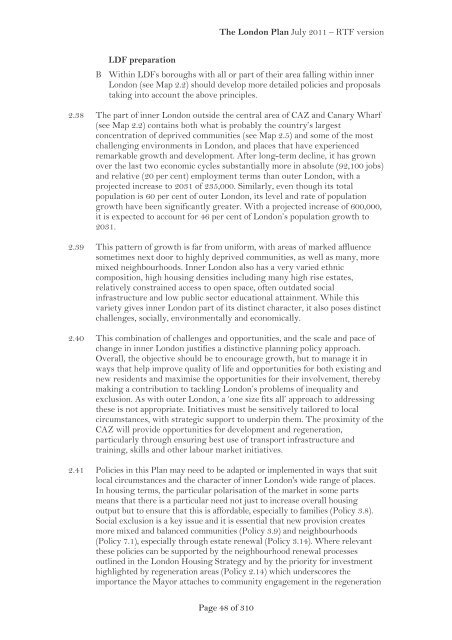London Plan 2011 PDF 1 MB - Lambeth Council
London Plan 2011 PDF 1 MB - Lambeth Council
London Plan 2011 PDF 1 MB - Lambeth Council
You also want an ePaper? Increase the reach of your titles
YUMPU automatically turns print PDFs into web optimized ePapers that Google loves.
The <strong>London</strong> <strong>Plan</strong> July <strong>2011</strong> – RTF version<br />
LDF preparation<br />
B Within LDFs boroughs with all or part of their area falling within inner<br />
<strong>London</strong> (see Map 2.2) should develop more detailed policies and proposals<br />
taking into account the above principles.<br />
2.38 The part of inner <strong>London</strong> outside the central area of CAZ and Canary Wharf<br />
(see Map 2.2) contains both what is probably the country’s largest<br />
concentration of deprived communities (see Map 2.5) and some of the most<br />
challenging environments in <strong>London</strong>, and places that have experienced<br />
remarkable growth and development. After long-term decline, it has grown<br />
over the last two economic cycles substantially more in absolute (92,100 jobs)<br />
and relative (20 per cent) employment terms than outer <strong>London</strong>, with a<br />
projected increase to 2031 of 235,000. Similarly, even though its total<br />
population is 60 per cent of outer <strong>London</strong>, its level and rate of population<br />
growth have been significantly greater. With a projected increase of 600,000,<br />
it is expected to account for 46 per cent of <strong>London</strong>’s population growth to<br />
2031.<br />
2.39 This pattern of growth is far from uniform, with areas of marked affluence<br />
sometimes next door to highly deprived communities, as well as many, more<br />
mixed neighbourhoods. Inner <strong>London</strong> also has a very varied ethnic<br />
composition, high housing densities including many high rise estates,<br />
relatively constrained access to open space, often outdated social<br />
infrastructure and low public sector educational attainment. While this<br />
variety gives inner <strong>London</strong> part of its distinct character, it also poses distinct<br />
challenges, socially, environmentally and economically.<br />
2.40 This combination of challenges and opportunities, and the scale and pace of<br />
change in inner <strong>London</strong> justifies a distinctive planning policy approach.<br />
Overall, the objective should be to encourage growth, but to manage it in<br />
ways that help improve quality of life and opportunities for both existing and<br />
new residents and maximise the opportunities for their involvement, thereby<br />
making a contribution to tackling <strong>London</strong>’s problems of inequality and<br />
exclusion. As with outer <strong>London</strong>, a ‘one size fits all’ approach to addressing<br />
these is not appropriate. Initiatives must be sensitively tailored to local<br />
circumstances, with strategic support to underpin them. The proximity of the<br />
CAZ will provide opportunities for development and regeneration,<br />
particularly through ensuring best use of transport infrastructure and<br />
training, skills and other labour market initiatives.<br />
2.41 Policies in this <strong>Plan</strong> may need to be adapted or implemented in ways that suit<br />
local circumstances and the character of inner <strong>London</strong>'s wide range of places.<br />
In housing terms, the particular polarisation of the market in some parts<br />
means that there is a particular need not just to increase overall housing<br />
output but to ensure that this is affordable, especially to families (Policy 3.8).<br />
Social exclusion is a key issue and it is essential that new provision creates<br />
more mixed and balanced communities (Policy 3.9) and neighbourhoods<br />
(Policy 7.1), especially through estate renewal (Policy 3.14). Where relevant<br />
these policies can be supported by the neighbourhood renewal processes<br />
outlined in the <strong>London</strong> Housing Strategy and by the priority for investment<br />
highlighted by regeneration areas (Policy 2.14) which underscores the<br />
importance the Mayor attaches to community engagement in the regeneration<br />
Page 48 of 310
















